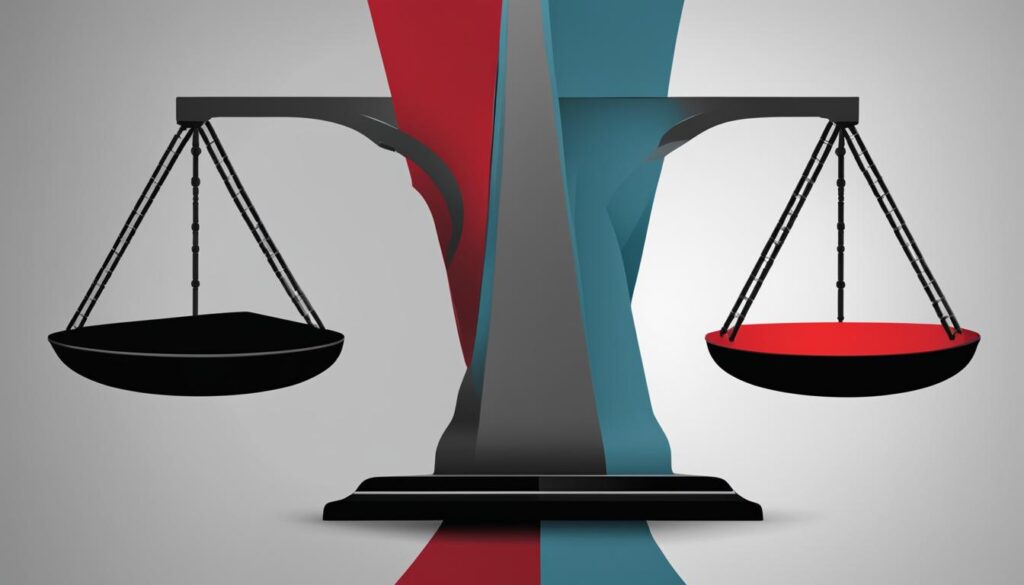The financial gender gap is a widely recognized issue that reflects gender disparities in various aspects of money management. It encompasses differences in financial knowledge, decision-making abilities, and economic outcomes between men and women. Understanding and addressing this gap is crucial for achieving financial equality and empowering individuals, regardless of their gender.
In this article, we will delve into the causes and consequences of the gender gap in financial literacy, exploring its impact on savings for retirement, investment choices, and economic stability. We will also discuss efforts being made to bridge this gap and promote financial equality between genders.
Key Takeaways:
- Gender disparities exist in financial literacy and decision-making.
- The gender gap can be influenced by confidence levels, financial decision-making within relationships, and knowledge gaps.
- Education and financial independence play vital roles in closing the gender gap.
- The gender gap has tangible effects on financial outcomes, such as income, wealth accumulation, and debt burden.
- Financial education and empowerment programs, along with policy interventions, are essential for addressing and reducing the gender gap.
The Gender Gap in Financial Literacy
When it comes to financial literacy, there is a clear gender gap that persists. Numerous surveys have consistently shown that women tend to perform worse than men on financial literacy tests, highlighting a significant disparity in women’s financial knowledge.
One contributing factor to this gap is the tendency for women to select “don’t know” as an answer more frequently than men. This hesitation or lack of confidence in their financial knowledge further widens the gender gap in financial literacy.
The implications of this gender gap are far-reaching. Women who have lower levels of financial literacy may encounter challenges in making informed financial decisions and engaging in positive financial behaviors. This includes aspects such as saving for the future, investing, and overall financial planning.
To further understand the extent of the gender gap, it is essential to delve into the factors that contribute to this discrepancy. The upcoming sections will explore these factors in-depth, shedding light on the various influences that impact women’s financial literacy and ways to bridge the gap.
Factors Impacting the Gender Gap
The gender gap in financial literacy is influenced by several factors that contribute to disparities in knowledge and confidence levels, as well as financial decision-making dynamics.
Confidence: Women may face lower confidence levels in their financial knowledge, which can hinder their willingness to make important financial decisions. This lack of confidence often stems from societal and cultural factors, as well as a lack of exposure to financial education and resources.
Financial Decision-Making Dynamics: The division of financial responsibilities within relationships can play a role in the gender gap. Women may have less exposure to financial decision-making, relying on their partners or family members to handle financial matters. This limited involvement can result in lower financial literacy levels and perpetuate the gap.
Knowledge Gaps: Another significant factor contributing to the gender gap in financial literacy is knowledge gaps. Women may have limited access to financial education and resources, resulting in lower levels of financial literacy. This can be attributed to the lack of emphasis on financial education in school curricula and the barriers in accessing financial information and tools.
To reduce the gender gap in financial literacy, it is important to address these factors. Encouraging women to build confidence in their financial knowledge, promoting shared decision-making in financial matters, and improving access to comprehensive financial education resources can empower women to make informed financial decisions and bridge the gender gap.
The Role of Education and Financial Decision-Making
Education plays a significant role in narrowing the gender gap in financial literacy. Women with higher levels of education tend to have higher financial literacy scores. Additionally, promoting financial independence and shared decision-making within relationships can improve women’s financial literacy, as they gain more experience and knowledge in managing their finances.
Education and Financial Literacy
Studies consistently show that education has a positive impact on financial literacy. Women who pursue higher education have a better understanding of financial concepts and are more confident in making financial decisions. This correlation between education and financial literacy underscores the importance of accessible and comprehensive financial education programs for women.
Financial Independence and Empowerment
Financial independence is a crucial aspect of women’s empowerment. When women have control over their finances and make decisions about their money, they gain confidence and a sense of agency. This empowerment can lead to improved financial literacy and a better understanding of personal finance.
“Financial independence is not just about having money; it is about making informed decisions and having the knowledge and skills to navigate the financial landscape effectively.” – Jane Thompson, CEO of a leading financial education organization.
Shared Decision-Making and Knowledge Sharing
Shared decision-making within relationships can also contribute to women’s financial literacy. When couples engage in open and transparent conversations about money, they can exchange knowledge and perspectives, enhancing both partners’ financial literacy. This collaborative approach fosters shared responsibility and builds a foundation for long-term financial success.
The Importance of Financial Education
Financial education plays a pivotal role in promoting financial independence and shared decision-making. By providing women with the necessary knowledge and skills, financial education programs empower them to take control of their finances and make informed choices. These programs cover a wide range of topics, including budgeting, saving, investing, and retirement planning, equipping women with the tools they need to achieve financial security.
By investing in education and encouraging shared decision-making, we can empower women to take charge of their financial lives, narrow the gender gap in financial literacy, and pave the way for greater financial equality.
The Impact of the Gender Gap on Financial Outcomes
The gender gap in financial literacy has significant consequences for financial outcomes, highlighting the importance of addressing this issue to ensure economic equality and financial well-being for women. When it comes to income disparity, women tend to have lower levels of income compared to men. This inequality hinders their ability to build wealth and achieve financial security.
Furthermore, women face challenges in wealth accumulation. They often have less access to investment opportunities and are more likely to experience career interruptions due to caregiving responsibilities. These factors contribute to the wealth gap between genders, limiting women’s long-term financial stability.
In addition to income and wealth disparities, women also bear a slightly higher debt burden, particularly in terms of credit card debt. This can further hinder their financial progress and limit their ability to allocate funds towards savings or investments.
Addressing the gender gap in financial literacy is crucial for promoting financial equality and improving financial outcomes for women. By providing educational resources, empowering women to make informed financial decisions, and implementing policies that promote equal opportunities, we can work towards closing the gap and creating a more equitable financial landscape.
| Financial Outcome | Gender Disparity |
|---|---|
| Income | Women tend to have lower levels of income compared to men. |
| Wealth Accumulation | Women face challenges in wealth accumulation due to limited access to investment opportunities and career interruptions. |
| Debt Burden | Women carry a slightly higher credit card debt burden. |

By addressing these disparities, we can foster economic empowerment and financial well-being for women, ultimately leading to a more inclusive and equal society.
Addressing the Gender Gap: Education and Empowerment
To address the gender gap in financial literacy, it is crucial to focus on financial education and empowerment programs targeted at women. Providing accessible and comprehensive financial education can equip women with the knowledge and skills to make informed financial decisions. Empowerment programs that promote financial independence and confidence can also play a significant role in closing the gender gap and fostering financial equality.

Financial Education: Equipping Women with Knowledge and Skills
Financial education is key to bridging the gender gap in financial literacy. By providing women with the necessary knowledge and skills, they can make informed financial decisions, manage their money effectively, and plan for their financial future. Programs that offer accessible and comprehensive financial education, covering topics such as budgeting, saving, investing, and retirement planning, can empower women to take control of their finances.
Empowerment Programs: Promoting Financial Independence and Confidence
Empowerment programs for women play a crucial role in closing the gender gap. These programs aim to enhance financial independence and build confidence in making financial decisions. By addressing social and cultural barriers, empowering women to negotiate salaries, and providing mentorship and support networks, these programs can contribute to narrowing the financial gender gap. Empowered women are more likely to actively participate in financial decision-making and take charge of their financial well-being.
“Financial education empowers women, equipping them with the knowledge and confidence to pursue their financial goals and build a secure future for themselves and their families.”
By combining financial education and empowerment programs, we can create a transformative environment that enables women to overcome barriers, navigate financial challenges, and achieve financial equality. These initiatives are essential in closing the gender gap in financial literacy and building a more inclusive and equitable financial landscape.
Policy Interventions for Financial Equality
Policy interventions play a crucial role in the pursuit of financial equality between genders. By implementing targeted measures, governments and institutions can address the systemic challenges that perpetuate gender disparities in the financial realm. These interventions focus on promoting gender equality, financial inclusion, and support for women-owned businesses.
One key area of policy intervention is the promotion of financial inclusion. Governments can work towards creating an inclusive financial system that addresses the specific needs and challenges faced by women. This involves ensuring access to financial services, such as banking, credit, and insurance, for all individuals, regardless of gender or socioeconomic status.
Bridging the gender pay gap is another important policy intervention. Establishing equitable wage structures and enforcing equal pay legislation can contribute to reducing financial disparities between genders. By ensuring that women receive fair and equal compensation for their work, financial opportunities become more accessible, leading to improved overall financial outcomes for women.
Furthermore, policy interventions can focus on providing support for women-owned businesses. This includes implementing initiatives that facilitate access to capital, mentorship programs, and training opportunities. By leveling the playing field, women entrepreneurs can navigate financial challenges more effectively and contribute to economic growth and prosperity.
Policy interventions for financial equality are essential in addressing the gender gap in financial literacy. Through concerted efforts, governments and institutions can create an environment that promotes gender equality and empowers women to achieve financial independence and success.

Policy Interventions for Financial Equality
The table below provides an overview of key policy interventions for achieving financial equality between genders:
| Policy Intervention | Description |
|---|---|
| Financial Inclusion | Ensuring access to financial services for all individuals, regardless of gender or socioeconomic status. |
| Equal Pay Legislation | Enforcing laws and regulations that promote equal pay for equal work. |
| Support for Women-Owned Businesses | Implementing initiatives to facilitate access to capital, mentorship programs, and training opportunities for women entrepreneurs. |
Conclusion
The gender gap in financial literacy is a critical issue that has profound implications for women’s financial well-being and economic empowerment. Women consistently score lower on financial literacy tests compared to men, highlighting the need for targeted interventions to address this disparity.
By addressing factors such as confidence levels, education, and financial decision-making dynamics, progress can be made towards achieving financial equality between genders. Providing accessible and comprehensive financial education is crucial in equipping women with the knowledge and skills to make informed financial decisions.
Empowerment programs that focus on promoting financial independence and confidence can play a significant role in closing the gender gap in financial literacy. Additionally, policy interventions aimed at promoting financial inclusion and addressing gender pay disparity can contribute to creating a more inclusive and equal financial landscape for all.
It is imperative that we continue to work towards closing the financial gender gap and strive for progress towards equality. By empowering women with financial knowledge and creating supportive policies, we can ensure that everyone has equal opportunities to achieve financial well-being and economic success.
How Does Cultural Influence Contribute to the Financial Gender Gap?
The role of culture in financial learning is significant in perpetuating the financial gender gap. Cultural norms and expectations often limit women’s access to education and economic opportunities, leading to a lack of financial literacy and empowerment. Addressing these cultural influences is essential in closing the gender gap in finance.
How Does Economic Inequality Contribute to the Financial Gender Gap?
Economic inequality has a significant societal impact – particularly on the financial gender gap. Women, who often earn less than men, are disproportionately affected by this issue. This disparity leads to fewer financial resources for women, contributing to the ongoing financial gender gap and perpetuating gender inequality in the economy.
FAQ
What is the gender gap in financial literacy?
The gender gap in financial literacy refers to the disparity between men and women in their knowledge and understanding of financial concepts and practices.
What factors contribute to the gender gap in financial literacy?
The gender gap in financial literacy can be influenced by factors such as confidence levels, financial decision-making dynamics within relationships, and knowledge gaps.
How does education impact the gender gap in financial literacy?
Women with higher levels of education tend to have higher financial literacy scores, highlighting the role of education in narrowing the gender gap.
What are the consequences of the gender gap in financial literacy?
The gender gap in financial literacy can result in lower levels of income, wealth, and liquid assets for women, as well as a slightly higher credit card debt burden.
How can we address the gender gap in financial literacy?
Addressing the gender gap requires providing accessible and comprehensive financial education, empowering women through programs that promote financial independence and confidence, and implementing policy interventions to promote financial inclusion and gender equality.

